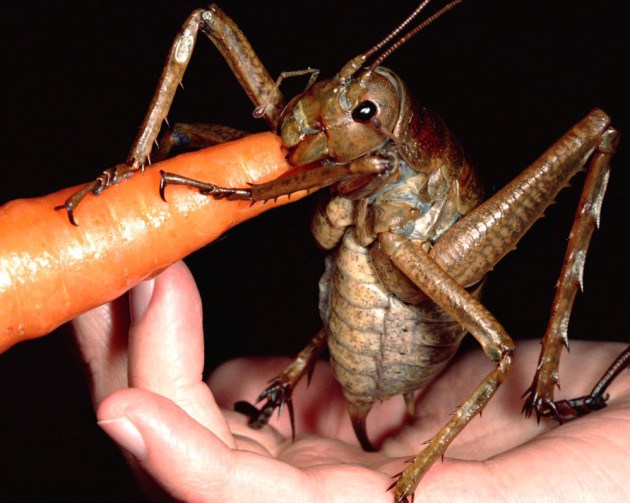
The Little Barrier Island Giant Weta (Deinacrida heteracantha) has several claims to fame. It is old enough to have seen the dinosaurs come and go. It is the biggest grasshopper in the world, and it is also the world’s heaviest insect.
There are over 70 species of weta in New Zealand—the only place on earth they live. Weta comes from the Maori word wetapunga which means ‘god of ugly things’. They are among New Zealand’s most recognisable insects, with big bodies and spiny legs. Wetas are nocturnal, and live in a variety of habitats including grassland, shrub land, forests and caves. They excavate holes under stones, rotting logs, in trees or move into pre-formed burrows. Groups of weta include tusked, cave, ground, tree, as well as giant. Of the nine giant weta species, the Little Barrier Island Giant Weta is the biggest.
This species certainly lives up to its name. They can grow to up to 10cm (four inches) long, excluding legs and antennae. Their body mass is usually around 35g but can be heavier if it is a female with eggs, with one individual reportedly weighing 71g. They can also hop up to 60cm (two feet) at a time, and are very long-lived insects, with adults living for over a year.
It is restricted to Little Barrier Island off the coast of New Zealand because it has been exterminated from the mainland thanks to non-native predators. Having evolved alongside native predators such as birds, reptiles and bats (i.e. non terrestrial mammals) the introduction of unfamiliar predators such as rats, cats, dogs and pigs resulted in a sharp increase in predation rates and corresponding population declines. Now, giant weta and several other species of weta throughout New Zealand are at risk of extinction.
Isolation is the explanation for their huge size. They are an example of a biological phenomenon known as ‘island gigantism’, which occurs when something small grows big to take advantage of a gap in the ecosystem. This gap could be caused by a lack of predators or competition which would otherwise be present on the mainland and constrain body size. The larger size benefits the animal because there is a decreased vulnerability to a scarcity of food or water, which is a greater threat on islands than on the mainland. They can survive for longer periods of time without them or travel further to find them.
The Little Barrier Island Giant Weta is one of New Zealand’s most recognisable insects, and has been an icon for invertebrate conservation in the country. They may not be cute or furry or naturally garner much sympathy from the public, but they need our help if we are to save these fascinating and unique animals.
